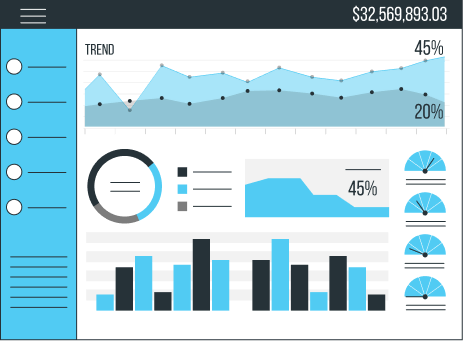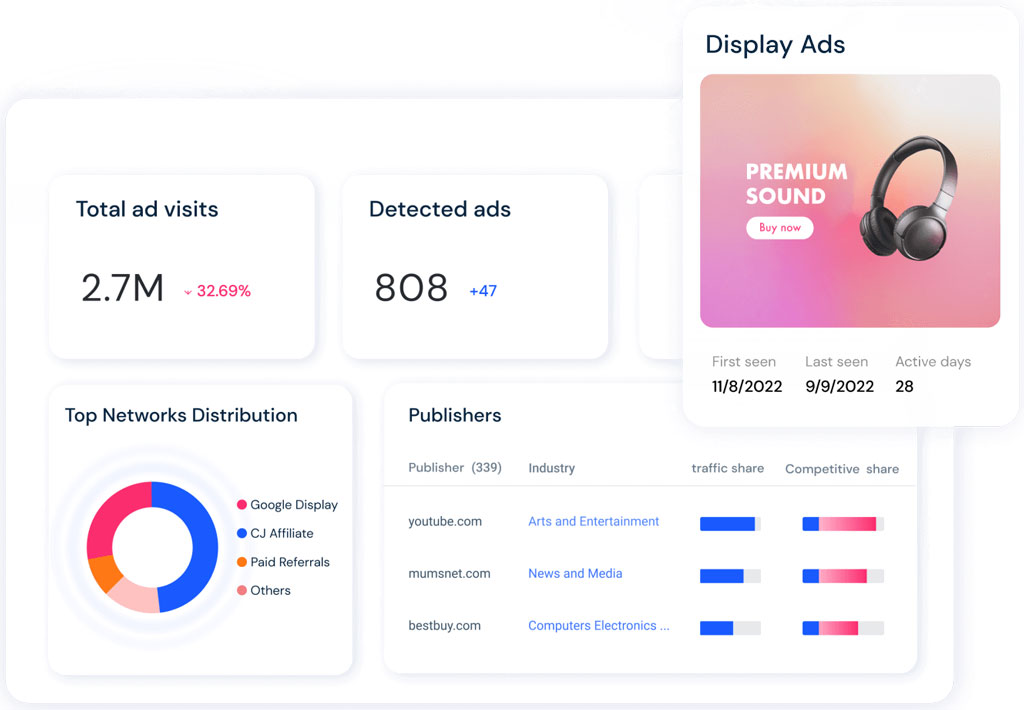Navigating the complexities of pay-per-click (PPC) advertising can be challenging, especially in the dynamic landscape of evolving competition and customer expectations. As 65% of potential customers click on paid ads, which provide a 200% ROI, three-quarters of brands consider PPC advertising an effective way to boost their businesses, and 62% of them are planning to increase their PPC budgets (Brainlabs The State of PPC 2018-2019). PPC competitor analysis offers valuable insights into the strategies and performance of other industry players. With the ever-changing competition, PPC competitive analysis isn’t just a one-time task but an ongoing effort.
With 80% of companies globally conducting PPC campaigns with Google Ads and the top three paid ads getting close to 50% of all clicks, knowing and outperforming the competition is essential (Unbounce). Understanding competitor moves can refine your own campaigns, ensuring optimised keyword targeting, engaging ad copy, and efficient spending. Regular checks uncover new market opportunities and trends, revealing not just direct industry competitors but also external players, like Amazon, who bid across sectors. In this guide, we’ll break down the steps for a comprehensive PPC competitor analysis. From identifying key players to evaluating their strategies and ROI, these insights will position you to outpace the competition in the ever-competitive digital advertising space.
Step 1: Pinpoint Your Competitors
Embarking on a PPC competitive analysis begins with identifying the competitors. The digital advertising environment is a dynamic field where new players emerge, and existing ones evolve. Internal discussions, particularly with sales and marketing teams, can throw light on well-established rivals.
Search engine results pages (SERPs) also provide valuable insights into your high-ranking rivals. If you need a more detailed picture of the competition, paid tools like Semrush offer the capabilities required for getting a comprehensive view of your competitors and identifying the primary and secondary ones.
In addition, tools like Google Ads Auction Insights can provide a holistic view of your online competitors, highlighting those bidding on similar keywords and revealing metrics such as:
- Impression share: Compares the frequency of your ad impressions against potential impressions.
- Overlap rate: Indicates concurrent ad impressions with competitors.
- Position above rate: Highlights instances where competitors’ ads rank higher than yours.
- Top of the page rate: Signifies how frequently a competitor’s ad appears at the page’s pinnacle.
- Outranking share: Measures how often your ad ranks above a competitor’s in auctions.
Understanding the various types of PPC competitors is important for developing the right strategy. Here are some of the most common types of competitors.
- Direct Competitors: Businesses offering identical products or services as yours. They’re your most immediate threat and often the most recognizable.
- Indirect Competitors: They cater to the same audience but offer different solutions. For instance, a gym and a diet app both target fitness enthusiasts but in unique ways.
- Affiliates & Marketing Partners: These can be double-edged swords. While they promote your brand, they might also promote your competitors, typically for commission.
- Comparison Shopping Engines: Platforms like Kelkoo bring multiple products under one roof, making it easier for users to compare and choose.
- Search Arbitrages: They bid on keywords to redirect users to another search platform, enhancing their traffic at your expense.
- Resellers: These might be selling your product or services but could also be offering alternatives, making them indirect competitors.
Step 2: Study the PPC Strategy of the Competition
Outpacing competitors in PPC campaigns requires a profound understanding of their strategy and building on it. Here’s a structured approach to analyzing the tactics that rivals employ.
Keyword Research
Note that SEO SEA synergy is an effective strategy that allows advertisers to dominate both organic and paid channels. Therefore, the first element to study is the keywords competitors are targeting in their PPC campaigns. While some keywords might be obvious from SEO analysis, paid campaigns might feature different terms.
Tools like Similarweb can provide insights into competitors’ primary keywords, showcasing where they’re putting their emphasis and potential budget allocation.
By acquiring these details and utilizing solutions, such as SEMRush’s Keyword Gap tool and Ahrefs, you can gain a clearer understanding of your rivals’ keyword strategy, revealing areas where they might be outperforming or areas they’ve potentially neglected.
Ad Placement Insights
Identify the platforms where your competitors’ ads are most visible. Tools like Similarweb provide insights into the ad networks and platforms your rivals employ to reach your target audience.
Knowing whether competitors’ PPC campaigns appear on search engine results pages (SERPs), specific websites, or platforms like YouTube is instrumental in deciding where to position your ads.
Search Results Tracking
Monitor your competitor’s search engine standing, the ad copies they employ, and their expenditure on ads. Various free and paid tools provide such details that can help shape your bid tactics and ad content.
Leverage Ad Intelligence
For a more in-depth exploration, opt for platforms like Similarweb, Spyfu, and Semrush EyeOn. These tools can trace the evolution of your competitors’ ad campaigns, showcasing trends in their spending, click-through rates, and conversions, presenting a comprehensive overview of their PPC trajectory.
Step 3: Study the Ad Copy and Landing Pages of Your Competitors
The detailed exploration of rivals’ ad copy and landing pages allows marketers to truly understand competitors’ strategies and gain an edge. This analysis aims to identify patterns, strengths, and areas of opportunity.
Take a Close Look at the Ad Copy
Content is the foundation of every advertising effort and success. To outperform competitors, you need to gain insights into the way they formulate their ads first. Here are the primary aspects to consider:
- Keyword Insights: Identify the keywords your competitors frequently use. Are there any recurring terms or phrases that stand out?
- Tone Analysis: Determine the tone they employ – is it friendly, formal, or humorous? This can provide clues about their target audience and brand voice.
- Visual Review: Examine the imagery or video content accompanying their ads. What emotions or messages are they aiming to convey through visuals?
- CTA Examination: Analyze their Calls to Action. Are they direct, persuasive, or subtle? This can indicate what they prioritize – urgency, information, or exploration.
- Consistency Check: Explore how the colours and design elements they use are consistently aligned with their broader brand identity.
- Ad Variations: Explore the different ad versions your competitors are running. Identify what makes their ad copy stand out and any enticing offers they are promoting.
- Historical Ad Analysis: Use specialized tools like iSpionage and SpyFu to trace the evolution of your competitor’s ad copy. Understanding past ad variations and their performance can offer insights into what works best.
Explore the Landing Pages of Your Competitors
The landing page is the ultimate destination the ad viewers are taken to. Therefore, it can make or break the deal. Analyze the landing pages linked to your competitors’ paid ads, paying attention to the following aspects:
- Content Coherence: Check if the landing page content aligns with the initial ad’s promise. A mismatch can indicate ineffective targeting or experimentation.
- Design Evaluation: Look at the layout – is it user-friendly and intuitive, or cluttered? This can hint at their user experience priorities.
- CTA Focus: Identify the primary action they want the visitor to take on the landing page. Is it easy to spot and compelling enough?
- UVP Assessment: By visiting their websites, determine each competitor’s unique value proposition (UVP). This will give you a clearer picture of their market positioning and how you can enhance your own UVP to be more distinct and appealing.
- Competitive Benchmarking: Utilize tools like Google’s auction report to pinpoint the top-performing landing pages of your competitors. What themes or tactics are common among the top performers?
Equipped with this in-depth analysis, you can better understand the choices your competitors make, helping you devise a more informed and strategic approach for your campaigns.
Step 4: Determine the Target Audience of Your PPC Competitors
Identifying your competitors’ target audience offers invaluable insights into potential market segments you might be overlooking. By analyzing their advertising patterns, you can understand if your PPC targeting aligns with industry trends or if there are untapped audience niches awaiting your attention.
First, examine who your competitors predominantly target with their PPC campaigns. Are they channel-specific, leaning more towards platforms like LinkedIn for B2B targeting? Do they emphasize specific job roles or seniority tiers? On the flip side, if their focus is B2C, discern if they cater to particular demographics such as age groups or gender profiles.
Leverage tools like Similarweb, Ahrefs, or Google Ads Keyword Planner to streamline your research. While monitoring online consumer behaviours and demographic shifts, take note of emerging trends that might influence PPC campaign outcomes.
It’s crucial to remember that your ideal customer profile (ICP) shouldn’t mirror your competitors’. Determine the nuances and curate distinctive audience segments. Explore further to identify underserved audiences that your primary competitors might be neglecting. Sometimes, the fiercest competitor might have minimal audience overlap, revealing untapped opportunities for you.
Step 5: Assess the Budget and Advertising Spend of the Competition
Gaining a strategic edge in PPC campaigns often depends on understanding the financial parameters behind your competitors’ ads. As keyword bids intensify and budgets constrict, knowing where and how your competitors allocate their funds can offer a roadmap to optimize spending on your end.
To determine the financial blueprint of your competitors:
- Leverage ad intelligence platforms like Spyfu or AdGooroo to obtain an in-depth look into their spending habits.
- Explore search engine rankings to identify any correlation between ad spend and visibility.
- Observe the frequency and placement of competitor ads across various platforms.
- Analyze their digital footprint, spanning from websites to social media, to gauge their advertising breadth.
- Engage with industry insiders to glean insights on prevailing budgetary norms.
These strategies not only offer a window into competitor spending but also illuminate areas of successful audience engagement. Tools like Similarweb’s PPC Spend tool can be instrumental, providing a side-by-side view of ad spend versus paid traffic, and illuminating successful spending decisions.
As PPC trends evolve, user behaviours shift, and competitors recalibrate their strategies, consistent monitoring is essential. Adopt tools like competitive trackers to streamline this process, focusing on paid search metrics. With the various solutions and ad intelligence alternatives available for businesses, the selection of the particular tools and strategies to implement can be overwhelming. A specialized Google ads agency can go a long way in helping you identify the most effective options.
Step 6: Keep Track of the PPC Competitor Performance and ROI
Evaluating your competitors’ PPC metrics and ROI gives you a clear benchmark in the market. By assessing their campaign outcomes and investment returns, you gain actionable insights to refine and enhance your own PPC strategies.
Here’s a roadmap to an effective analysis:
- Identify the Industry Benchmarks: Begin by diving into established benchmarks for your sector. For instance, Wordstream’s 2023 Google Ads Benchmarks report offers a bird’s-eye view of standard metrics (source).
- Key Metrics to Monitor: It’s imperative to track vital statistics that elucidate campaign efficacy. This includes average positions, cost per click, cost per lead, CTR, impression share, cost per acquisition, and conversion rate.
- Utilize Ad Intelligence Tools: Platforms such as Spyfu and Ahrefs are invaluable in this endeavour. They provide granular insights into aspects like which keywords competitors are targeting, variations in their ad copy, and their estimated ad spend.
- Estimate Competitor ROI: While extracting the exact ROI figures for a competitor is challenging, one can deduce a ballpark figure. By examining their ad spend in tandem with estimated conversion rates, you can infer their potential returns.
A comprehensive PPC competitive analysis requires a combination of industry data, specific metrics, and sophisticated tools, culminating in an informed estimation of your rivals’ ROI.
Master Analysing Competitor’s PPC Campaigns
Analysing your competitors’ PPC campaigns is an actionable strategy to sharpen your advertising efforts. Regularly monitoring the competition provides insights into their marketing tactics, enabling you to identify gaps in your own campaigns and adjust accordingly.Utilise advanced tools like Spyfu or Ahrefs for a deeper dive into competitors’ performance metrics. However, tools only provide raw data, and the interpretation lies with you. Partnering with a PPC agency helps turn the figures into valuable insights and tangible outcomes. Expert support and constant vigilance ensure you catch shifts in competitors’ strategies, allowing you to react swiftly.















